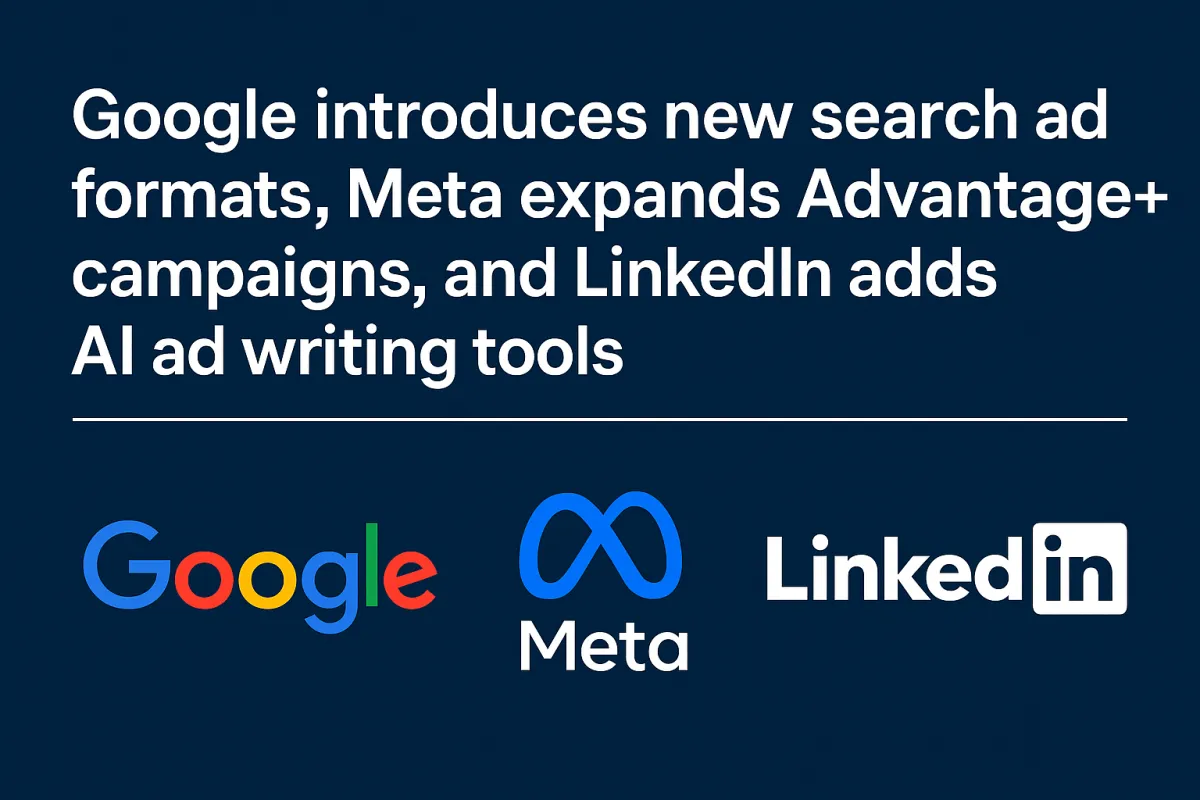
Google Introduces New Search Ad Formats, Meta Expands Advantage+ Campaigns, and LinkedIn Adds AI Ad Writing Tools
The digital advertising landscape continues to evolve at lightning speed, with major platforms rolling out innovations designed to make campaigns smarter, faster, and more personalized. In this latest wave of updates, Google, Meta, and LinkedIn are introducing powerful new features that redefine how advertisers connect with audiences. From Google’s new search ad formats to Meta’s enhanced automation tools and LinkedIn’s AI-assisted ad writing, these developments mark a new era of performance-driven marketing.
Google Introduces New Search Ad Formats
A Focus on Visual and Interactive Ads
Google is enhancing its search advertising experience by unveiling a new generation of ad formats designed to engage users more effectively. Moving beyond the traditional text-based layout, Google’s latest update brings visual and interactive elements into Search Ads — including image extensions, carousel-style product displays, and embedded video snippets.
These additions aim to create a richer, more immersive search experience where users can see and explore products directly from the search results page. For advertisers, this means an opportunity to make listings more eye-catching, improve click-through rates, and boost conversion potential.
AI-Powered Personalization and Automation
One of the most notable improvements is Google’s increasing reliance on AI-driven personalization. The new formats are tightly integrated with Google’s machine learning systems, which analyze user intent, context, and behavior to automatically serve the most relevant ad variations.
For example, if a user searches for “best running shoes,” Google’s AI may now display a carousel of products tailored to the user’s preferences — such as brand affinity, price sensitivity, and browsing history. This automation minimizes manual campaign setup while maximizing performance outcomes.
Impact on Advertisers
Advertisers can expect higher engagement rates thanks to the visual appeal and interactivity of these new ad formats. Moreover, with Google’s continuous improvements in Performance Max and Responsive Search Ads, marketers have more tools to reach customers at every stage of the buying journey — from discovery to conversion.
Meta Expands Advantage+ Campaigns
Automation at Scale
Meta is doubling down on automation with an expanded rollout of its Advantage+ campaigns, a feature that leverages AI to optimize ad delivery, targeting, and creative placement. Initially available for eCommerce and app promotion, Advantage+ campaigns are now being extended across additional objectives such as lead generation and brand awareness.
This system allows Meta’s algorithm to automatically test multiple creative combinations, find the most effective audiences, and allocate budgets dynamically — all with minimal human intervention. For advertisers, the result is a streamlined setup process that saves time while enhancing efficiency.
New Features and Reporting Tools
The latest update introduces advanced performance insights and transparency features, giving marketers a clearer view of how AI-driven decisions are made. Meta has also improved cross-platform data integration, allowing campaigns to perform seamlessly across Facebook, Instagram, and Audience Network.
Additionally, advertisers can now access creative-level reporting, enabling them to identify which visuals or ad copies perform best and replicate success across campaigns. This combination of automation and actionable insights gives brands greater control over AI-optimized advertising.
What It Means for Marketers
Meta’s expansion of Advantage+ campaigns signals a continued shift toward hands-off campaign management, where AI handles optimization and budget allocation. While this approach reduces manual workload, it also requires marketers to focus more on strategic inputs — such as audience definitions, creative direction, and performance review — rather than constant micromanagement.
LinkedIn Adds AI Ad Writing Tools
AI-Powered Creativity for Professionals
LinkedIn, the go-to platform for B2B marketers, has entered the AI race with the introduction of AI ad writing tools integrated directly into its Campaign Manager. This new feature uses generative AI to help advertisers craft compelling ad copy, headlines, and descriptions tailored to specific audiences and campaign goals.
The tool leverages data from LinkedIn’s vast professional network to suggest content that resonates with the target demographic — for instance, crafting different tones and messaging for executives, recruiters, or sales professionals.
By integrating AI into the creative process, LinkedIn aims to help marketers save time while maintaining authenticity and relevance.
How It Works
When creating a campaign, advertisers can input basic information such as their offer, target audience, and preferred tone. The AI then generates multiple ad variations, which can be reviewed, edited, or used as inspiration. The system is also designed to improve over time, learning from engagement data to produce better recommendations.
This tool aligns with LinkedIn’s broader push toward AI-assisted marketing, complementing its recent launch of predictive audiences and automated bidding options.
Benefits for B2B Marketers
LinkedIn’s AI ad writing tools are a game changer for professionals managing multiple campaigns or clients. By automating the copywriting process, marketers can focus more on campaign strategy and audience engagement rather than spending hours fine-tuning ad text. It’s also an equalizer for smaller businesses that may not have dedicated copywriters — allowing them to create high-quality ads quickly and efficiently.
The Bigger Picture: AI-Driven Advertising Ecosystem
The simultaneous updates from Google, Meta, and LinkedIn highlight a clear industry trend: artificial intelligence is at the core of modern digital advertising. From creative generation to audience targeting and campaign optimization, automation is rapidly transforming how ads are created, delivered, and measured.
While these tools simplify execution, they also demand that marketers evolve their roles — focusing more on strategic thinking, creative vision, and ethical use of data. The future of advertising isn’t about replacing humans with AI but enabling smarter collaboration between both.
Conclusion
With Google introducing visually engaging search ad formats, Meta expanding automated campaign capabilities, and LinkedIn empowering advertisers with AI copywriting tools, digital marketing is entering a new era of innovation. These advancements promise greater efficiency, creativity, and personalization — setting the stage for a smarter, more connected advertising ecosystem in 2025 and beyond.